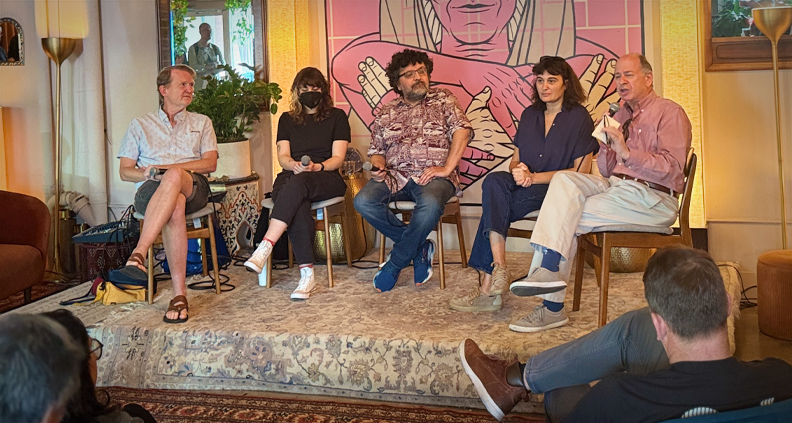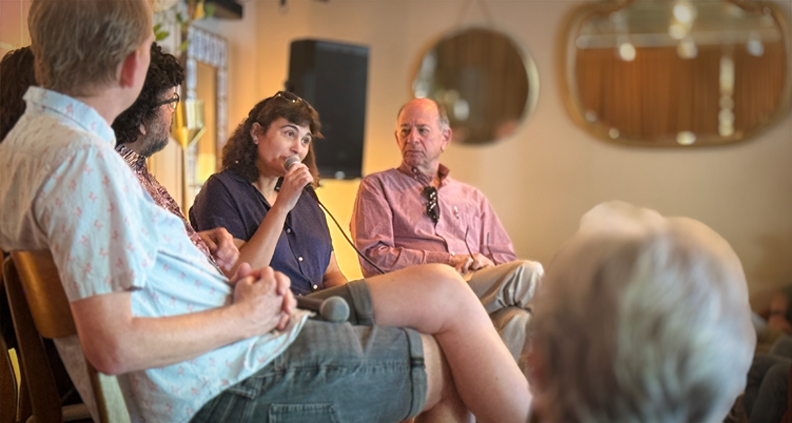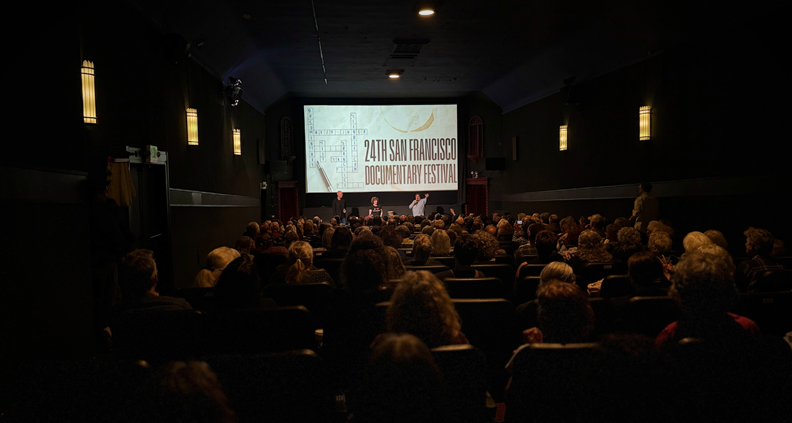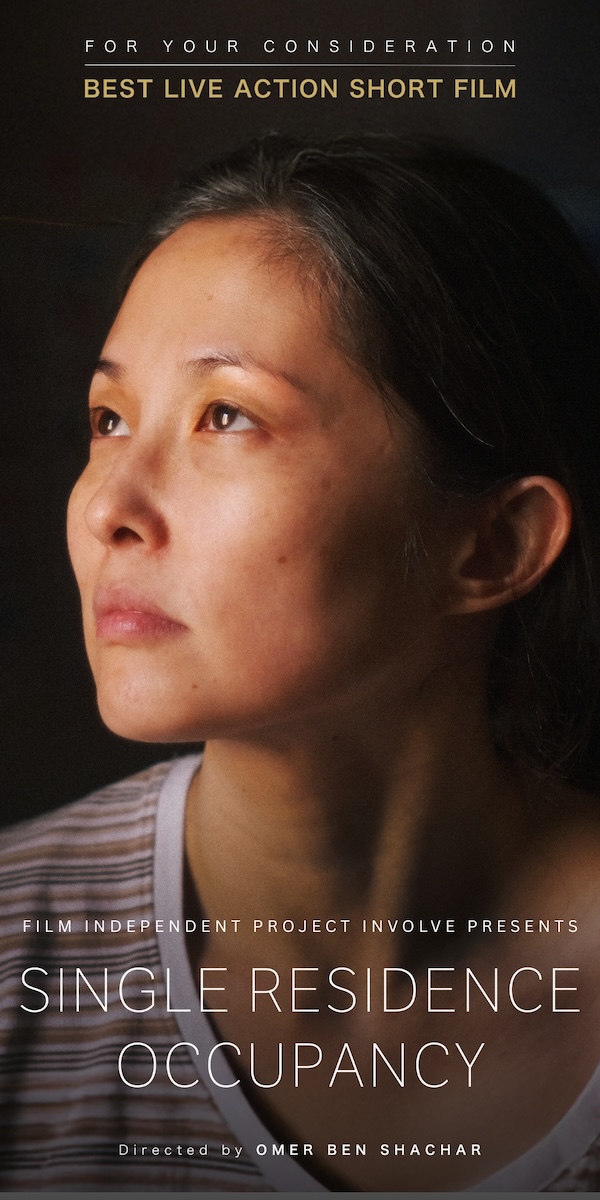Festival Visions: Film Fests – What Are They Good For?
Film festivals… whether you’re a filmmaker, goer, or both, you may find yourself wondering, ‘What are they good for?’ Well, for one, they’re a great place to attract an audience. They give your film legitimacy, a theatrical premiere, and the potential for distribution. Festivals are also an ideal way to connect with other filmmakers, creatives, and the people who champion them— programmers.
At an illuminating panel during the SF DocFest earlier this month titled ‘Film Festivals – What Are They Good For?’, film critic Michael Fox spoke with programmers Rod Armstrong (SFFFILM), Dominique O’Neil (San Francisco Jewish Film Festival), Sterling Hedgpeth (Mill Valley Film Festival), and Isabel Fondevilla (Roxie Theater) about this very question. They discussed how they approach programming for their individual festivals/venues, the future of independent film and festivals overall, and how independent filmmakers can use them to their advantage.

Programmer Dominique O’Neil acknowledged a decline in support of the arts in general, specifically grants for art and the people who make and support it. Without skirting around these current challenges, panelists were hopeful about the future. They all voiced the importance of coming together to see and discuss films. Films connect us to different experiences and each other. As a society, we rely on filmmakers to help us make sense of the world. Festivals are an essential space for creating art and community; something these programmers will continue to champion.
With the overcrowded landscape of streaming, audiences often get overwhelmed and have difficulty navigating or finding films they want to watch. Panelists pointed out that this has allowed festivals to go back to their roots in some ways, showing films you wouldn’t otherwise have an opportunity to see.
With theaters under duress from streaming competition, Isabel Fondevilla of the Roxie Theater wanted to highlight the important role independent cinemas play in the festival landscape. Venues like the Roxie, in the heart of the Mission District in San Francisco, attract audiences thanks to their location and reputation as a cultural landmark, making people more likely to see your film if it gets into a festival hosted there.
HOW TO DO FESTIVALS BETTER
It might seem obvious, but marketing is critical, and filmmakers play a role. When putting together your press kit, Rod emphasized the stills you submit are crucial. Sometimes, the image might not be strong enough to convey what the film is about, and risks losing audience interest as a result. ‘Don’t just have a picture of your two lead characters standing next to a car, or… in a conversation.’ Look for images that are more dynamic, that give programmers more of a choice. Many filmmakers make the mistake of only sending one still. Films are a visual medium. When it comes to marketing, don’t skimp on the imagery.
Another reality of festivals is that not every film is meant for the big house. As filmmakers, the goal is to touch as many people as possible, but programmers emphasize that sometimes touching even one person with your work can be enough. That’s the beauty of festivals. While programmers like to challenge audiences, some films are a tougher sell, and play better in a packed house of 45 seats, as opposed to a half empty theater that can seat 233. Some films aren’t for everyone, but that intimacy can create a better experience.
Programmers were also open about relying on filmmakers to help bring in an audience for their premieres. Grassroots cast and crew campaigns to help fill seats go a long way.
SPECIFICITY MATTERS
The Roxie Theater in San Francisco hosts several festivals, and programmer Isabel spoke about the symbiotic relationship between independent theaters and festivals. ‘Festivals are a good indicator of the ongoing local scene. If the festival is doing well, we’re doing well.’ She noted that local theaters pay attention to what’s resonating with audiences. If everyone is calling about a particular film playing at a festival, that informs their programming.

‘Drawing attention to local talent and local work is a key element of American independent cinema’, said Rod. The audience for these particular programmers’ festivals is primarily in the Bay Area, which allows for local premieres. This is especially important for filmmakers whose work has a strong sense of place, or subject matter unique to the area where the festival takes place. For many independent films, these festivals might be the only theatrical run they have. By focusing on local festivals eager to showcase their work, filmmakers have the opportunity to experience a premiere with an enthusiastic, local audience, as well as have a better chance of standing out in a crowded festival landscape.
Some fun facts for filmmakers considering Bay Area festivals: The city is the second largest film market in the country, which allows their festivals to garner strong local press, as well as industry reviews. The Bay Area also has the third highest concentration of Academy members. If a filmmaker wants to make an awards push, it’s worth considering local Bay Area festivals to gain additional campaign traction.
However, ‘it’s very difficult and very expensive to run a film festival’, said Sterling, programmer of the Mill Valley Film Festival. Programmers face many challenges, not least of which is needing people to go see the films they program, so they can make enough money to keep their festivals running. Because of Mill Valley’s fall run and the prominence of Academy members in the Bay Area, they have to configure programming around buzzier films looking to make an awards push to draw in audiences and revenue. However, they don’t want to ‘lose the spirit of how we started’, so they still make an effort to highlight independent filmmaking, diverse voices, and local talent.
While some filmmakers may want to premiere at a general interest festival to attract a broader audience, many filmmakers may see a benefit from premieres at identity festivals like the San Francisco Jewish Film Festival. Identity festivals have a built-in audience, said Dominique, and programmers around the country look at their programming, which can project your work into other festivals.
In general, staying up-to-date on local opportunities and identity festivals can be of huge benefit to filmmakers. ‘If you’re not on the email list of every film organization, every festival in this area, you should do that’, said Rod.
While FilmFreeway is the predominant method filmmakers use to submit projects, there’s no way to designate whether or not you’re a local filmmaker to festivals. In that instance, reach out to programmers. Letting them you’re local can go a long way in programming consideration. And when you do reach out, be sure to mention your plan for outreach. ‘Are you having a Q&A or a special guest?’ Using locality to bring in an audience is key.
TAKE CONTROL OF YOUR OWN DESTINY
An encouraging takeaway for any filmmaker from the panel is that these programmers aren’t gatekeepers, but approachable champions of movies and the people who make them.
All the panelists encouraged filmmakers to be proactive and reach out to programmers to make them aware of your work. (Within reason, of course.) Rod joked he doesn’t need multiple emails about the same project, but it’s never a bad idea to reach out and introduce yourself. Since these programmers work with various programs and festivals throughout the year, it’s important to put your project on their radar. That way, if your film doesn’t get into its target festival, there are still other opportunities that may come up, and having awareness of you and your project makes them more likely to program it elsewhere.

If a festival already premiered your film, make sure to reach out when your next project is ready. Rod emphasized that they value those kinds of relationships with filmmakers and want to stay in touch. ‘If we like a film, whether we book it or not, we want to know what they’re up to next.’
Beyond the relationship with programmers, festivals are a great way to build connections and network with other creatives. Use the badge to your advantage, advised Sterling. ‘We’ve seen collaborations blossom from these kinds of connections, these opportunities to network with other filmmakers’ whose movies may screen before or after yours.
LONG LIVE CINEMA
There’s no denying that arts institutions like festivals and independent theaters are struggling. The good news is that film festivals want to continue to challenge themselves and audiences to step outside their comfort zones. As filmgoers become less risk-averse, seeking ‘maybe five films’ they know they’ll like, Rod encouraged them to ‘pick two more’ they wouldn’t normally consider.
As far as programmers’ role in sustaining the future of festivals, Sterling says, ‘…we cannot rest on a sense of complacency when it comes to programming.’ Part of that is maintaining a high level of energy year round, promoting in-person appearances and Q&A screenings outside of limited festival windows. The goal is to draw in audiences and get them excited about engaging with filmmakers and creatives through these events. ‘Make movie going a habit’, said Michael Fox. This slogan used to be printed at the bottom of the theater listings page, but it bears repeating.
For over 40 years, Film Independent has helped filmmakers get their projects made and seen. The nonprofit organization’s core mission is to champion creative independence in visual storytelling in all its forms, and to foster a culture of inclusion. We support a global community of artists and audiences who embody diversity, innovation, curiosity and uniqueness of vision. To support our mission with a donation, click here.
Keep up with Film Independent…
Header image: John Squire
Additional images provided by: San Francisco IndieFest

